Printmaking: Marcell Feldberg and Nicolas Poignon
This interview is part of a series of interviews which we are conducting with contemporary artists represented by Emanuel von Baeyer – Cabinet, who use printmaking in their work. Each interview focuses on a particular printmaking technique for which the artist is known. It explores the challenges, experiences and sources of inspiration associated with working with that specific technique.
“We succeeded in something which is very rarely successful – simultaneously working alongside and with each other.”
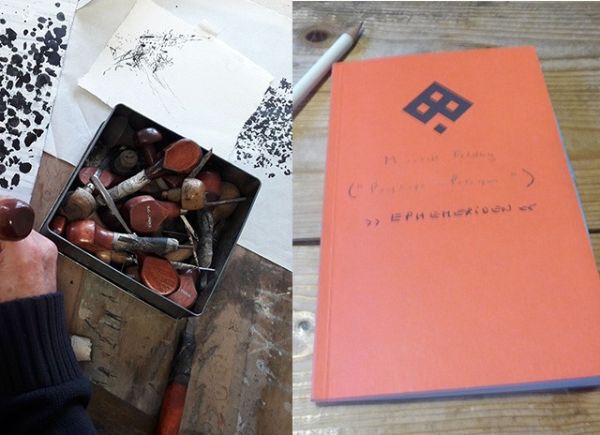
EvB: Rather than asking a question, I think I’ll begin this interview by telling our readers how I met you both. They were different routes, of course, but they led to the same point. Marcell, I first met you at the European Fine Art Fair in Maastricht. I noticed you at my stand: you stood in front of a small pastel work, examined it intently, viewed it up close and from a distance. And then I noticed that you had a little notebook in your hand which you were writing in. I came up to you, we spoke, and you told me what you do. ‘Picture descriptions?’ I asked, to which you responded, ‘No, these aren’t painting descriptions.’ How many volumes are there now? How many volumes of your ‘non- painting descriptions’?
MF: There are now three published volumes of ‘Archiv der Bilder’ (‘An archive of paintings’). A fourth is in progress.
EvB: And how many texts in each volume?
MF: About a hundred texts per volume. Some have more, some fewer.
EvB: Right, so that’s about 400 texts on fine art: about 400 thoughts on a painting, on different paintings, on different types of painting. I wanted to say, too, how I met Nicolas. It was your work that made you stand out for me, in particular the linocuts. What fascinated me was your technique, and not only because this technique is seldom used in comparison to other print techniques. In fact, of the techniques available to them, artists use linocut the least, as far more often they prefer etching, woodcut and lithography. Then suddenly I see an artist who creates masterpieces through linocut – not by dint of the technique itself, but rather the motif, or the structure of the piece. And what fascinated me here was the relative clarity of the motif, one or two motifs. Cityscapes, buildings, landscapes – totally classic, scenes we’re all familiar with. And suddenly you see something rather playful. Raindrops, snow, wind feature in the depiction. So, we have these two different structures, the construction of the motif besides the playful. For me, this is all to do with storytelling. In hindsight, it might have been that my associating your artwork with poetry inspired this project, albeit subconsciously. Decisions like these come from the gut. So, I decided that you should look at each other’s work with an open mind. Marcell, how was it meeting a new colleague, as it were? How did you go about things?
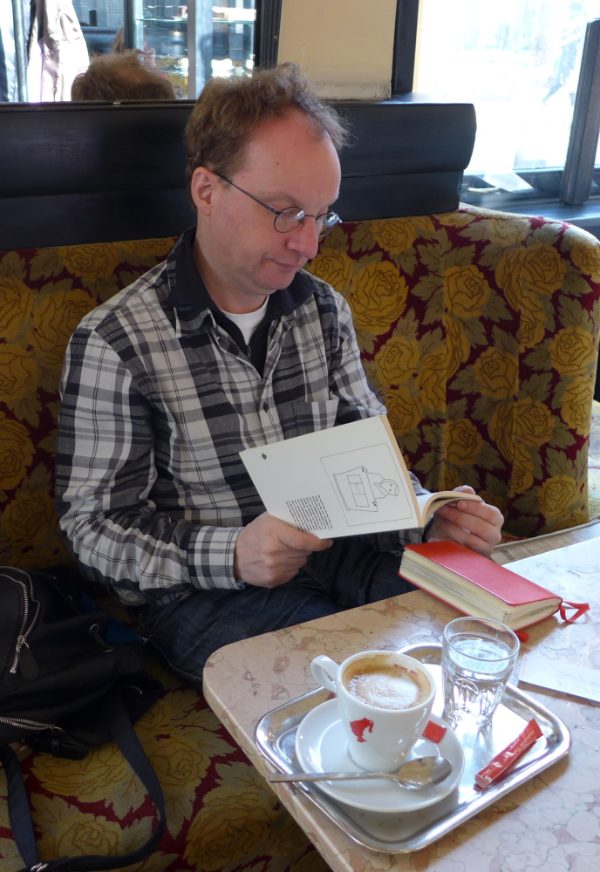
MF: I found a picture of Nicolas at your stand at TEFAF, Emanuel. The picture reminded of the painter Karl Walser, brother of Robert Walser, who disappeared in the snow. That was the first point of contact, so to speak, when you said, ‘You’re the only one to have made that connection’. So I wrote a piece in which I talked about this experience, and then you had the idea of putting me in contact with Nicolas. We got in touch, corresponding by traditional snail mail, to simply get a feel of what one or the other of us was writing, or painting, or setting in linocut. And what I found great was that, as different as we both are, and as different as our working approaches may be, correspondence between us quickly gained pace. We noticed pretty quickly that we had a strong rapport despite all our differences: exactly what you were talking about, really, with the idea of a poetic connection. Depictions of city and countryside are of course something that continues to fascinate me: the dichotomy of being close to the city, but at the same time being in the countryside. And it was this dichotomy which fuelled our correspondence, both literally in terms of our exchanging letters, but also internally in terms of the rapport we built.
EvB: Nicolas, how was it for you?
NP: I had already bought and read two of Marcell Feldberg’s books – which wasn’t without its challenges of course, given that they’re in German, which isn’t my native language. And to begin with I didn’t understand a thing. But gradually I began to understand parts, and I liked the style a lot. They’re like diaries – topographical descriptions of landscapes and walks which I liked very much. And suddenly I had this idea of pictures, of doing a project together, and an idea that came to me straight away was the theme of light. I don’t know why, but something bright, something light. The concept of light is totally foreign to me. My work is dark for the most part. I mostly work at night. I was working with the night and Marcel’s descriptions, and I saw something bright, something light, something spontaneous. And that was a perfect impression for my artwork.
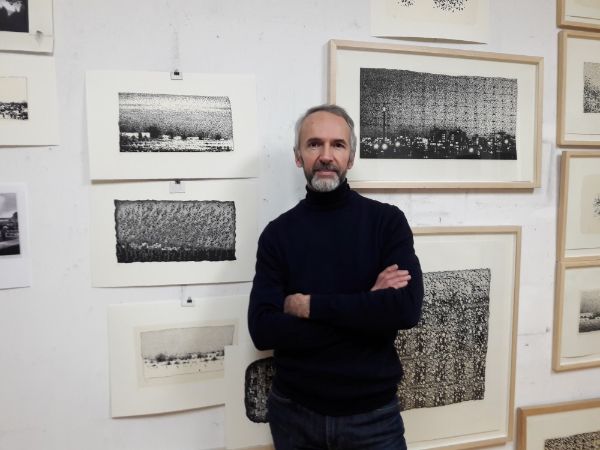
EvB: So that was the first association between the two of you – an association which hasn’t changed your own work as such, but rather has been a means of combining it. In almost all cases it is easier to portray darkness in linocut; light is still a challenge for your medium. Of course, the project was all quite open and gave you both plenty of freedom. At the same time, it wasn’t meant to be solely illustrative – it was meant to be a two-way collaboration, working for and alongside each other. Marcel, how did you find it?
MF: Yes, it was exactly that which I found so enjoyable. As we’ve said, Nicolas had these particular approaches which I saw in his artwork – whether cityscapes or landscapes. And what I really liked about our correspondence was that we always stayed independent to a degree. It became clear early on that we were working alongside each other – but only in correspondence. I would get excited about drafts that he sent me, and then I would reply with drafts or ideas of my own, almost on impulse. And that, I think, is what became the secret of our project. I think we succeeded in something which is very rarely successful – simultaneously working alongside and with each other. That’s what our correspondence meant for me. For me, it doesn’t have to mean always thinking alike, but rather finding that unity in working alongside each other.
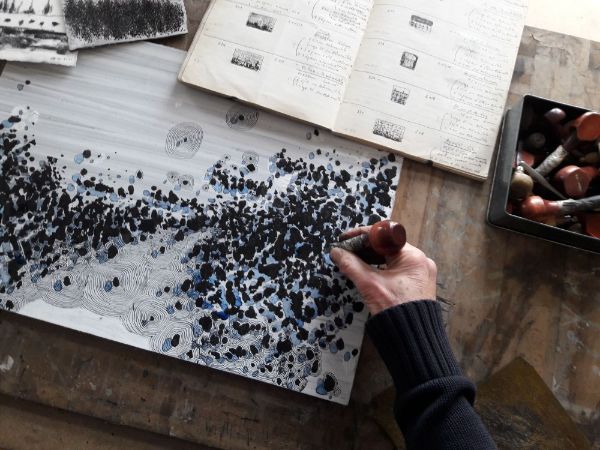
EvB: Nicolas, is that something you’d also reiterate, or is there something you would add?
NP: Yes, working with a ‘poet’ is nothing new for me. I read a lot and am comfortable working with texts. I also often get ideas or inspiration from texts. I found it interesting working with Marcell because his work isn’t just illustrative as such. It suited me very well to be a bit freer.
EvB: Are we now seeing in your artwork how the formality of a static building morphs into something else?
NP: Naturally when I’m reading something, I don’t simply want to illustrate the word ‘building’ or ‘snow’ as soon as I come across it. I don’t have a direct association with snow which lends itself to representation in painted or other form. It is and stays snow for me. I don’t simply want to illustrate the snow or the building.
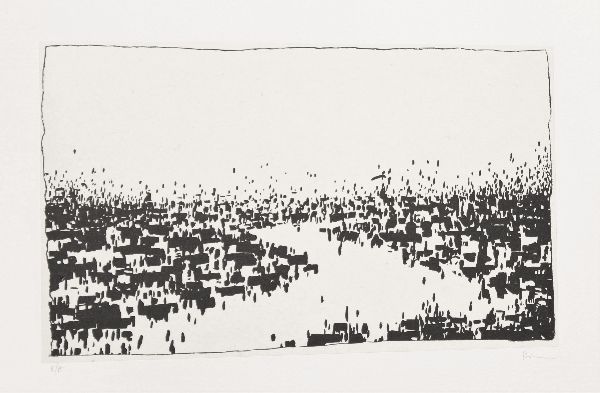
EvB: So, the project is now finished. It’s presented as a portfolio, with texts to accompany each piece of work, side by side. We gave the layout a lot of thought, didn’t we?
MF: You can see on the pages of text that the lines, words, thoughts are laid out in a random, scattered way like the title, ‘Ephemeriden’, which is a mishmash of sorts: on the one hand individual stars, on the other whole constellations. And when I then look for that in Nicolas’ works, I see first how the scattered pieces are drawn together into one cohesive picture – how for the viewer the disparate becomes the whole.
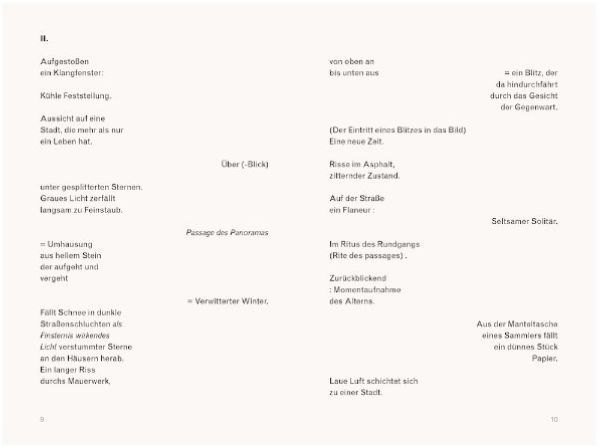
NP: For me, a book remains a book, and the same goes for a portfolio. You leaf through the pages and there you have the text, there the picture. You can’t change that. And so you begin reading the text, and gradually take in the picture. I love the concept of that. That’s how a book should be for me. It’s wonderful. Marcell has his own technique and that’s also wonderful. I wanted to know how he works. Is it like with sketching?
MF: So, to begin with I just had the impressions that I had gleamed from the first picture I bought, and then from the following picture. The first was a landscape; the second was a view of a building. When I was then clear that I was going to do something with it and spend time on it, I got a notebook and kept it with me. And then I began to collect things – ideas, sentences, single words, newspaper cuttings – which I then made a careful note of or glued into my notebook. And then I began to organise texts or lines of texts, and thus came about the notebook that you mentioned just now, Emanuel – the red notebook that I take wherever I go. During my time as an organist, I heard the gospel read many a time, and sometimes a line would resonate with me in such a way that I’d grab my notebook and make a note of it. “He who lives in the country shall not go into the city” – this line was so striking for me that it just had to go in. And these would then make their way into the other sketchbook, which grew and grew over time. In other words, it really was from these small, disparate collection pieces – these disparate, ephemeral pieces – that I built the whole thing. That’s how I operate. So it’s a collage really, but a collage always strongly focused on the object, condensed down in this notebook. And at some point I ended up at a kind of sequence of texts.
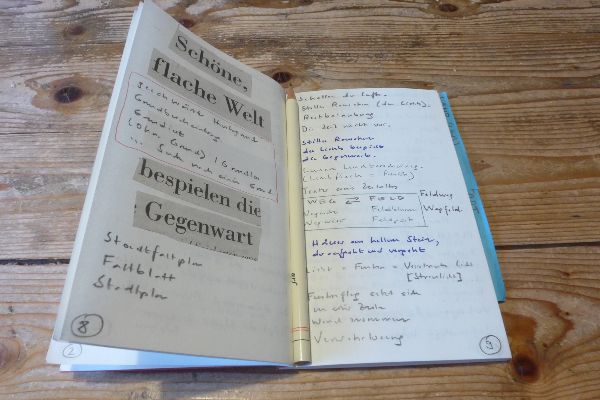
EvB: That’s very true! How do you work, Nicolas? What techniques do you use?
NP: I do a lot of drawings inspired by nature; I do a lot of sketches, and even more drawings. And when I have plenty of drawings, I get the idea of combining them into some larger picture. Only then do I start making small sketches for the linoleum, and if I like it I enlarge it before transferring. And the project with Marcell was exactly the same. I did a lot of sketches and drawings inspired by nature, like keeping a diary. In some ways, Marcell and I work alike.
EvB: That’s very true! How do you work, Nicolas? What techniques do you use?
NP: I do a lot of drawings inspired by nature; I do a lot of sketches, and even more drawings. And when I have plenty of drawings, I get the idea of combining them into some larger picture. Only then do I start making small sketches for the linoleum, and if I like it I enlarge it before transferring. And the project with Marcell was exactly the same. I did a lot of sketches and drawings inspired by nature, like keeping a diary. In some ways, Marcel and I work alike.
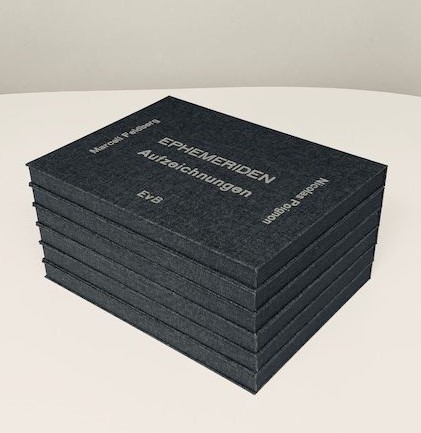
[German translation by Edward Buxton.]
Browse Nicolas Poignon at Emanuel von Baeyer – Cabinet
